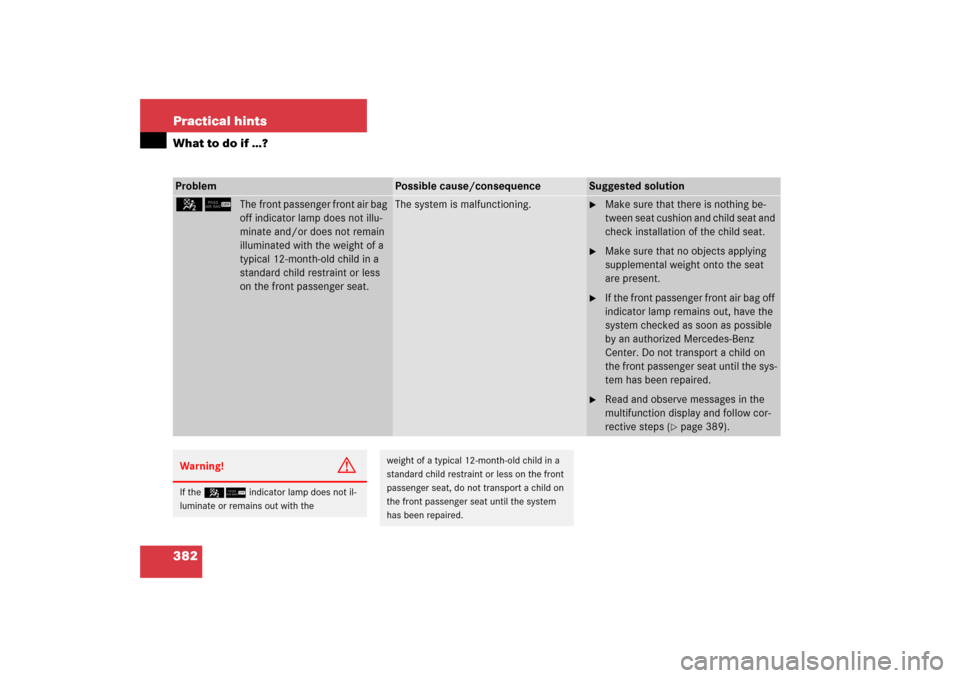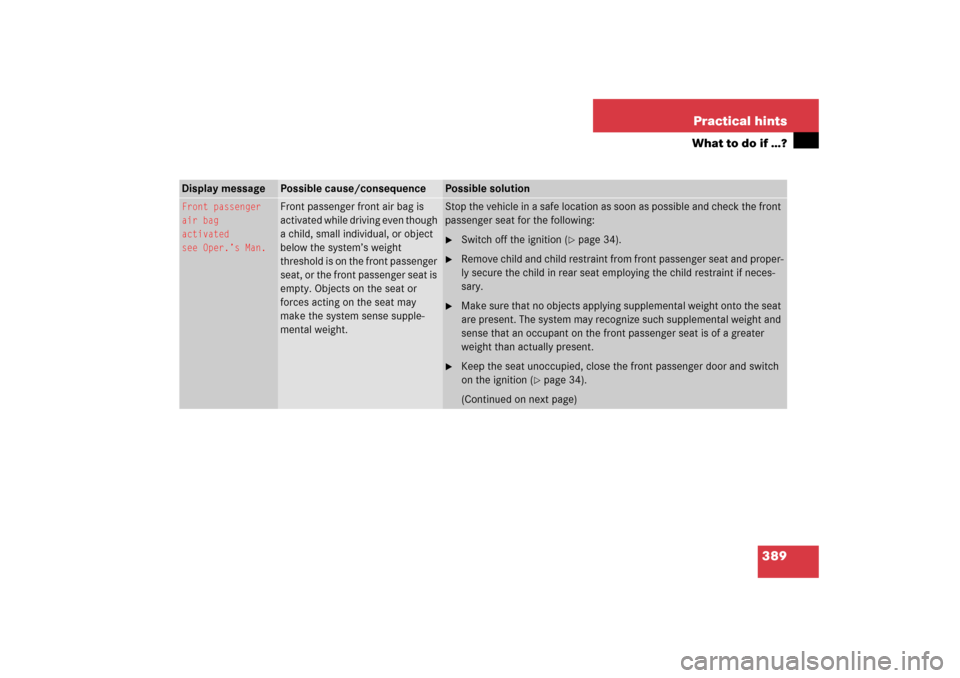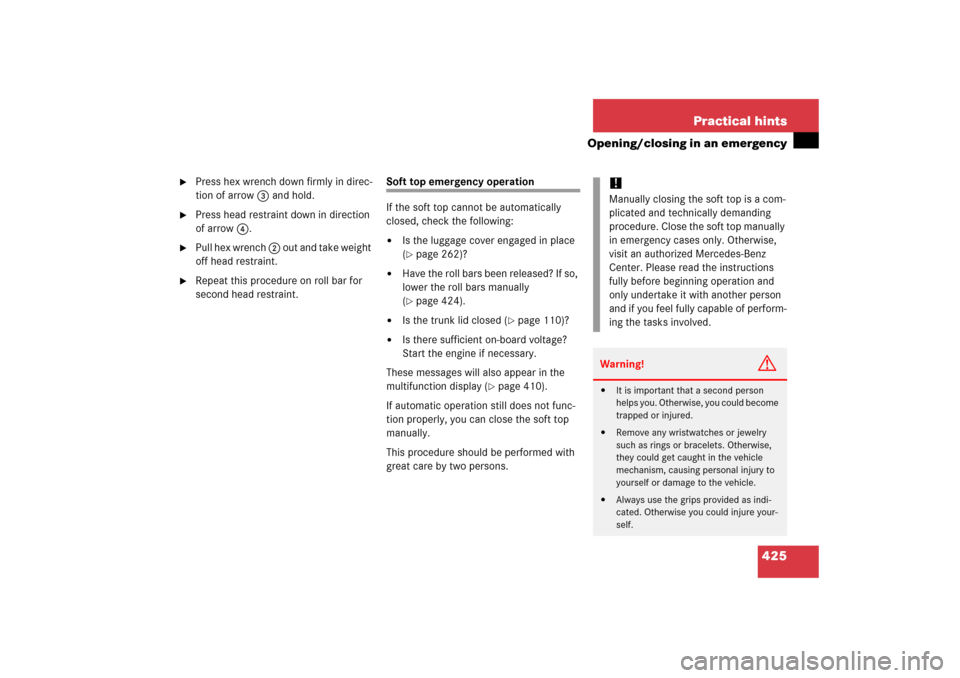Page 382 of 514
381 Practical hints
What to do if …?
Lamp in center consoleProblem
Possible cause/consequence
Suggested solution
56
The front passenger front air bag
off indicator lamp illuminates
and remains illuminated with the
weight of a typical adult or some-
one larger than a small individual
on the front passenger seat.
The system is malfunctioning.
�
Have the system checked as soon as
possible by an authorized
Mercedes-Benz Center.
�
Read and observe messages in the
multifunction display and follow cor-
rective steps (
�page 389).
Warning!
G
If the 56 indicator lamp illuminates
and remains illuminated with the weight of a
typical adult or someone larger than a small
individual on the front passenger seat, do
not have any passenger use the front
passenger seat until the system has been
repaired.
Page 383 of 514

382 Practical hintsWhat to do if …?Problem
Possible cause/consequence
Suggested solution
56
The front passenger front air bag
off indicator lamp does not illu-
minate and/or does not remain
illuminated with the weight of a
typical 12-month-old child in a
standard child restraint or less
on the front passenger seat.
The system is malfunctioning.
�
Make sure that there is nothing be-
tween seat cushion and child seat and
check installation of the child seat.
�
Make sure that no objects applying
supplemental weight onto the seat
are present.
�
If the front passenger front air bag off
indicator lamp remains out, have the
system checked as soon as possible
by an authorized Mercedes-Benz
Center. Do not transport a child on
the front passenger seat until the sys-
tem has been repaired.
�
Read and observe messages in the
multifunction display and follow cor-
rective steps (
�page 389).
Warning!
G
If the 56 indicator lamp does not il-
luminate or remains out with the
weight of a typical 12-month-old child in a
standard child restraint or less on the front
passenger seat, do not transport a child on
the front passenger seat until the system
has been repaired.
Page 390 of 514

389 Practical hints
What to do if …?
Display message
Possible cause/consequence
Possible solution
Front passenger
air bag
activated
see Oper.’s Man.
Front passenger front air bag is
activated while driving even though
a child, small individual, or object
below the system’s weight
threshold is on the front passenger
seat, or the front passenger seat is
empty. Objects on the seat or
forces acting on the seat may
make the system sense supple-
mental weight.
Stop the vehicle in a safe location as soon as possible and check the front
passenger seat for the following:�
Switch off the ignition (
�page 34).
�
Remove child and child restraint from front passenger seat and proper-
ly secure the child in rear seat employing the child restraint if neces-
sary.
�
Make sure that no objects applying supplemental weight onto the seat
are present. The system may recognize such supplemental weight and
sense that an occupant on the front passenger seat is of a greater
weight than actually present.
�
Keep the seat unoccupied, close the front passenger door and switch
on the ignition (
�page 34).
(Continued on next page)
Page 392 of 514
391 Practical hints
What to do if …?
Display message
Possible cause/consequence
Possible solution
Front passenger
air bag
deactivated
see Oper.’s Man.
Front passenger front air bag is deac-
tivated while driving even though an
adult or someone larger than a small
individual is occupying the front pas-
senger seat. Forces acting on the
seat may make the system sense a
decrease in weight.
Stop the vehicle in a safe location as soon as possible and check the
front passenger seat for the following:�
Switch off the ignition (
�page 34).
�
Have the front passenger vacate the seat and exit the vehicle.
�
Keep the seat unoccupied, close the front passenger door and
switch on the ignition (
�page 34).
(Continued on next page)
Page 426 of 514

425 Practical hints
Opening/closing in an emergency
�
Press hex wrench down firmly in direc-
tion of arrow3 and hold.
�
Press head restraint down in direction
of arrow4.
�
Pull hex wrench 2 out and take weight
off head restraint.
�
Repeat this procedure on roll bar for
second head restraint.
Soft top emergency operation
If the soft top cannot be automatically
closed, check the following:�
Is the luggage cover engaged in place
(�page 262)?
�
Have the roll bars been released? If so,
lower the roll bars manually
(�page 424).
�
Is the trunk lid closed (
�page 110)?
�
Is there sufficient on-board voltage?
Start the engine if necessary.
These messages will also appear in the
multifunction display (
�page 410).
If automatic operation still does not func-
tion properly, you can close the soft top
manually.
This procedure should be performed with
great care by two persons.
!Manually closing the soft top is a com-
plicated and technically demanding
procedure. Close the soft top manually
in emergency cases only. Otherwise,
visit an authorized Mercedes-Benz
Center. Please read the instructions
fully before beginning operation and
only undertake it with another person
and if you feel fully capable of perform-
ing the tasks involved. Warning!
G
�
It is important that a second person
helps you. Otherwise, you could become
trapped or injured.
�
Remove any wristwatches or jewelry
such as rings or bracelets. Otherwise,
they could get caught in the vehicle
mechanism, causing personal injury to
yourself or damage to the vehicle.
�
Always use the grips provided as indi-
cated. Otherwise you could injure your-
self.
Page 452 of 514
451 Practical hints
Flat tire
Lowering the vehicle�
Lower vehicle by turning crank coun-
terclockwise until the full weight of the
vehicle is resting on the ground.
�
Remove the jack.
1 - 5 Wheel bolts
�
Tighten the five wheel bolts evenly,
following the diagonal sequence
illustrated (1 to 5), until all bolts are
tight. Observe a tightening torque
of 80 lb-ft (110 Nm).Before storing the jack, it should be fully
collapsed, with handle folded in (storage
position) (
�page 415).
�
Store the jack and the other vehicle
tools in the trunk.Warning!
G
Have the tightening torque checked after
changing a wheel. The wheels could come
loose if they are not tightened to a torque of
80 lb-ft (110 Nm).
Page 466 of 514
465 Technical data
Parts service
Warranty coverage
Identification labels
Layout of poly-V-belt drive
Engine
Rims and tires
Electrical system
Main dimensions and weights
Fuels, coolants, lubricants, etc.
Page 479 of 514
478 Technical dataMain dimensions and weightsMain dimensionsWeightsModel
CLK 350
CLK 500
CLK 55 AMG
Overall vehicle length
183.3 in (4 657 mm)
183.3 in (4 657 mm)
183.3 in (4 657 mm)
Overall vehicle width
(exterior rear view mirrors
folded out)
78.4 in (1 991 mm)
78.4 in (1 991 mm)
78.4 in (1 991 mm)
Overall vehicle height
55.6 in (1 413 mm)
55.4 in (1 408 mm)
55.4 in (1 408 mm)
Overall vehicle height when
opening/closing soft top
80.2 in (2 038 mm)
81.0 in (2 057 mm)
80.6 in (2 047 mm)
Wheelbase
106.9 in (2 715 mm)
106.9 in (2 715 mm)
106.9 in (2 715 mm)
Track, front
58.8 in (1 493 mm)
58.9 in (1 497 mm)
58.9 in (1 497 mm)
Track, rear
58.0 in (1 474 mm)
58.2 in (1 478 mm)
58.2 in (1 478 mm)
Trunk load max.
220 lbs (100 kg)